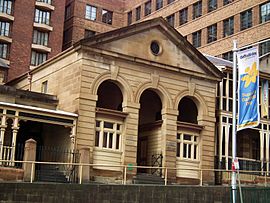Justice and Police Museum facts for kids

Phillip Street frontage of the museum
|
|
| Lua error in Module:Location_map at line 420: attempt to index field 'wikibase' (a nil value). | |
| Former name |
|
|---|---|
| Location | 4-8 Phillip Street, Sydney central business district, New South Wales, Australia |
| Type | Living history museum |
| Built | 1854–1886 |
| Architect |
|
| Architectural style(s) | Australian classic revival |
| Owner | Department of Justice |
| Official name: Justice and Police Museum; Police Station & Law Courts (former); Traffic Court | |
| Type | State heritage (built) |
| Criteria | a., c., d., e. |
| Designated | 2 April 1999 |
| Reference no. | 673 |
| Type | Police station |
| Category | Law Enforcement |
The Justice and Police Museum is a special place in Sydney, Australia. It used to be a police station and courthouse for the Water Police. Now, it's a museum where you can learn about the history of justice and policing in New South Wales. It's located on Phillip Street in the heart of Sydney.
Contents
History of the Museum Buildings
Early Days of the Water Police
In 1851, plans were made for a new Water Police Office. This office was for the police who looked after Sydney's busy harbour. Building work started in 1853, but it was slow. This was because many workers had left to search for gold during the gold rushes.
The first Water Police Office was finished in 1856. It had a main court and four other rooms. The Water Police Magistrate and his staff used these buildings. They handled cases related to harbour rules and water policing.
The Police Station is Built
A separate Water Police Station was built nearby in 1858. It had a ground floor with a charge room, offices, and cells. Upstairs, there were living quarters for four water policemen and their families. This building was designed to be like other police stations of that time.
Growing Courts and Police Work
Later, a second court was added in 1886. This new court handled smaller cases, while the older court became a "Charge Court." Over time, the buildings changed a lot. This was because the types of cases and police work kept growing.
In 1913, the Water Police moved some of their operations to a new location. The station on Phillip Street then became known as the Phillip Street Police Station. It became a main police station for the city. The courts there also started hearing cases about traffic offences. By 1926, they were known as Traffic Courts.
The courts stopped being used by court staff in 1979. This gave more space to the police station next door. Today, the site is managed by Sydney Living Museums. They run it as a museum about police and justice.
What You'll See Inside
The Historic Buildings
The museum is made up of two old courthouses and a police station. They were built in the 1800s for the Sydney Water Police.
- The first courthouse was built in 1856. It's a single-story building made of sandstone. It has a grand entrance with arches and columns.
- The police station was built in 1858. It's a two-story building also made of sandstone. It has a classic style with a special roof design.
- The second courthouse was added in 1886. It matches the style of the first courthouse.
These buildings have changed over the years. For example, new cells were added in 1875-76. Later, in the 1940s, the streets outside were lowered. This meant new stairs and walls had to be built.
The Museum Collection
The museum has a large collection, mostly about police history. It started with a collection of tools used by criminals from 1910. You can see old weapons, photographs, and documents. The museum is especially known for its collection of old firearms. It also has interesting forensic evidence from famous historical cases.
Why This Place is Important
The Justice and Police Museum is a very important historical site. It shows how law and order worked in early New South Wales. The buildings themselves are beautiful examples of old architecture. They stand out among the modern buildings in Sydney.
The museum also has a unique collection. It's the only public collection in New South Wales that focuses on the history of crime, law, and policing. It helps people understand how the law and police work, both in the past and today.
See also

